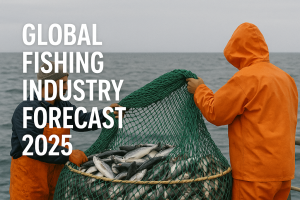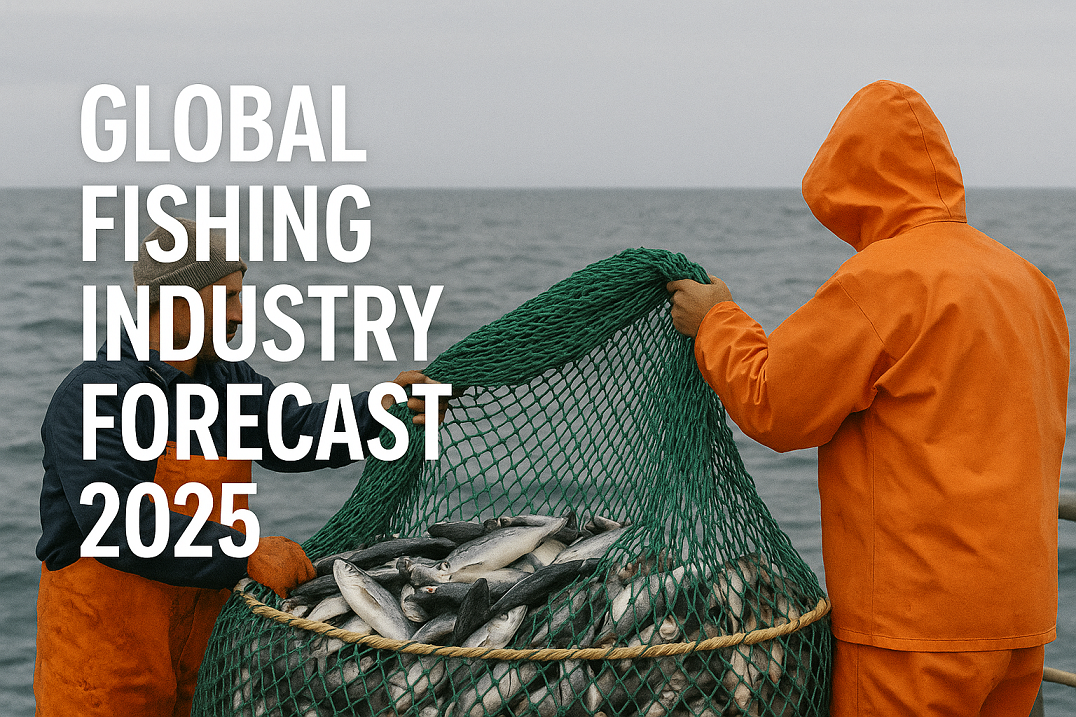Explore the 2025 global fishing industry forecast. Discover key trends, growth projections, market risks, and emerging opportunities in this deep dive into fishery economics and sustainability.”
Why the 2025 Fishing Industry Forecast Matters in Modern Maritime Operations
The fishing industry has long been a cornerstone of global food security, economic stability, and coastal livelihoods. But 2025 is shaping up to be a defining year. As demand for seafood surges and climate pressures intensify, maritime professionals, policymakers, and investors must understand the forces reshaping the industry.
According to the Food and Agriculture Organization (FAO), global fish consumption has increased more than fivefold since 1961. In 2025, seafood demand is projected to grow by an additional 7.5% compared to 2020 levels, driven by population growth, changing diets, and the rising appeal of high-protein, low-carbon foods. Yet this growth comes with challenges: overfishing, habitat degradation, supply chain disruptions, and geopolitical uncertainty.
Understanding fishing market trends and the fishery growth forecast for 2025 is critical—not only to ensure profitability and sustainability, but also to safeguard our oceans.

Key Developments and Drivers Behind the 2025 Outlook
Rising Global Seafood Demand
Consumer behavior continues to shift toward healthier and more sustainable diets. Seafood—especially aquaculture products like salmon, shrimp, and tilapia—meets this demand. According to the World Bank, aquaculture is projected to contribute over 60% of the world’s seafood by 2025.
Countries like China, India, Vietnam, and Indonesia remain dominant players, while regions like Sub-Saharan Africa and Latin America are emerging as fast-growing markets. The growth is also propelled by technological innovations such as recirculating aquaculture systems (RAS), which allow for fish farming in inland or urban areas with minimal environmental impact.
Digitalization and Smart Fisheries
The rise of AI, machine learning, and satellite technology is reshaping the fishing sector. Real-time vessel tracking, predictive analytics, and blockchain-based seafood traceability systems are becoming standard.
A 2023 study by Clarksons Research and Global Fishing Watch reported a 30% reduction in IUU (illegal, unreported, and unregulated) fishing activities in countries that adopted digital monitoring tools. Nations like Norway, Japan, and New Zealand lead in deploying smart fisheries tools, with policy support from IMO, UNEP, and regional fisheries bodies.
Aquaculture Expansion and Innovation
Aquaculture will be the dominant source of fishery growth in 2025. Technologies like biofloc systems, offshore fish cages, and AI-powered feeding mechanisms are helping to optimize yield while reducing waste and disease outbreaks.
Companies in Norway and Chile are now experimenting with deep-sea aquaculture platforms, designed to withstand strong currents and improve water quality for marine life. Meanwhile, startups in Singapore and the U.S. are pioneering lab-grown seafood to ease the pressure on wild fish stocks.
Climate-Resilient Practices
Climate change remains a major driver of change. Ocean warming is causing species migration, coral bleaching, and changes in spawning grounds. In 2025, more fisheries will need to adopt climate-resilient strategies, including:
- Flexible quota systems
- Marine protected area (MPA) expansion
- Integrated coastal zone management (ICZM)
The European Maritime Safety Agency (EMSA) and UNCTAD have emphasized adaptive marine governance as a key to long-term viability.
–
Risks Facing the Fishing Sector in 2025
Overexploitation of Wild Stocks
Despite sustainability initiatives, overfishing remains a significant threat. FAO data from 2024 indicates that over 34% of global stocks are still overfished. Particularly vulnerable are tuna species in the Western Pacific, cod in the North Atlantic, and sardines in West Africa.
Regulatory bodies like Regional Fisheries Management Organizations (RFMOs) are pushing for stricter enforcement, but gaps persist due to limited resources and political will.
Geopolitical and Trade Disruptions
Fishing zones are increasingly becoming flashpoints. Tensions in the South China Sea, Arctic, and North Atlantic have sparked conflicts over access rights, maritime boundaries, and EEZ violations.
Tariff disputes and sanctions can also disrupt the seafood trade. For example, the 2023 EU-China seafood tension resulted in a 15% drop in Chinese exports to Europe. In 2025, fishery operators must remain alert to geopolitical shifts and diversify their sourcing and export strategies.
Labour Rights and Social Issues
Labour exploitation, especially in deep-sea fleets, remains a pressing issue. According to the International Transport Workers’ Federation (ITF), many crew members on distant-water fishing vessels face dangerous conditions, low pay, and limited legal protection.
Some progress has been made. The ILO Work in Fishing Convention (C188) has been ratified by more than 20 nations, including the Philippines, France, and South Korea. However, enforcement remains inconsistent.
Environmental Pollution and Plastics
Microplastics and marine pollution not only harm marine life but also reduce the quality of seafood. The Marine Pollution Bulletin highlights that plastics have been found in over 30% of sampled commercial fish in coastal areas.
Governments are working on regulations for gear disposal and biodegradable nets. Some P&I Clubs now require environmental risk assessments for fishing operators as part of their underwriting process.
–
Real-World Applications: Country Snapshots
China: Balancing Growth and Sustainability
China remains the world’s largest seafood producer and consumer. It continues to invest heavily in aquaculture and overseas fisheries, including its Belt and Road Blue Economy Initiative. However, it is also under pressure to improve transparency, especially regarding IUU fishing in African and South Pacific waters.
China’s 2024 Five-Year Ocean Development Plan includes:
- Reduced subsidies for distant-water fleets
- Expansion of MPAs
- Stronger traceability systems
Norway: Leading with Smart Fishing
Norway combines sustainable policies with cutting-edge technology. Its digital quota management system, launched in 2022, has increased compliance by over 20%. As a leader in salmon aquaculture, it continues to drive innovation in offshore platforms and fish welfare.
Ghana: A Growing Player Tackling IUU Fishing
West Africa has long suffered from overfishing by foreign fleets. Ghana, with support from IMAREST and Norwegian aid programs, is working to improve domestic capacity through port inspections, community-based fisheries, and digital surveillance.
In 2025, Ghana is projected to increase its legal fish exports by 12%, a promising turnaround from previous years.
–
Future Outlook: 2025 and Beyond
Looking ahead, the fishing industry will become increasingly technology-driven, climate-sensitive, and ethically conscious.
Key projections include:
- Global seafood consumption to reach 186 million tonnes by end-2025.
- Aquaculture revenue expected to exceed USD 300 billion, led by Asia-Pacific.
- Expanded digital seafood supply chains, supported by blockchain and IoT sensors.
- Stronger integration of blue economy principles in national maritime strategies.
Fisheries that embrace transparency, innovation, and social equity will thrive. Those clinging to outdated models will face increasing scrutiny, regulation, and market exclusion.
Frequently Asked Questions
What is the outlook for global fishery growth in 2025? The industry is expected to grow by approximately 5–7%, with aquaculture leading the way. Wild-capture fisheries will see more stable, regulated yields.
Will seafood prices increase in 2025? Yes, modest price increases are expected due to supply chain constraints, energy costs, and climate-related disruptions. Premium products like bluefin tuna and organic salmon will be especially affected.
Which technologies are transforming the fishing sector? Key technologies include AI-powered monitoring, blockchain for traceability, automated feeding systems, satellite tracking, and recirculating aquaculture systems (RAS).
What are the biggest risks to fisheries in 2025? IUU fishing, geopolitical conflict, climate change, and pollution remain top risks. Labour rights issues also pose reputational risks for global brands.
How can countries ensure sustainable fishery growth? By investing in scientific management, adopting international agreements (e.g., PSMA, ILO C188), and promoting local community engagement.
Is lab-grown seafood viable? Still in early stages, but promising. Regulatory hurdles, cost, and consumer acceptance are the main challenges.
What is the role of the IMO in fisheries? While the International Maritime Organization (IMO) mainly regulates shipping, it plays a role in vessel safety, emissions, and training standards for fishing vessels.
Conclusion
The global fishing industry in 2025 stands at a crossroads. With rising demand, evolving technologies, and growing environmental pressures, stakeholders must act wisely to navigate this complex seascape.
From the ports of Shanghai to the fjords of Norway, from small island nations to industrial fleets, the path forward must balance growth with responsibility. Governments, corporations, and consumers alike have a role in shaping a seafood sector that respects people and the planet.
By embracing innovation, enforcing sustainability, and valuing marine ecosystems, we can ensure that the ocean’s bounty continues to feed the world—not just today, but for generations to come.
References
- FAO Fisheries & Aquaculture Department: https://www.fao.org/fisheries/en/
- World Bank Blue Economy Reports: https://www.worldbank.org/en/topic/oceans-fisheries-and-coastal-economies
- Global Fishing Watch: https://globalfishingwatch.org/
- ILO Work in Fishing Convention (C188): https://www.ilo.org/global/standards/subjects-covered-by-international-labour-standards/fishing/lang–en/index.htm
- Clarksons Research: https://www.clarksons.com/research/
- Marine Pollution Bulletin (Elsevier): https://www.sciencedirect.com/journal/marine-pollution-bulletin
- IMAREST: https://www.imarest.org/
- European Maritime Safety Agency (EMSA): https://emsa.europa.eu/
- UNCTAD Review of Maritime Transport: https://unctad.org/topic/transport-and-trade-logistics/review-of-maritime-transport
- The Maritime Executive: https://maritime-executive.com/
- Marine Insight: https://www.marineinsight.com/
- Journal of Marine Science and Engineering: https://www.mdpi.com/journal/jmse

